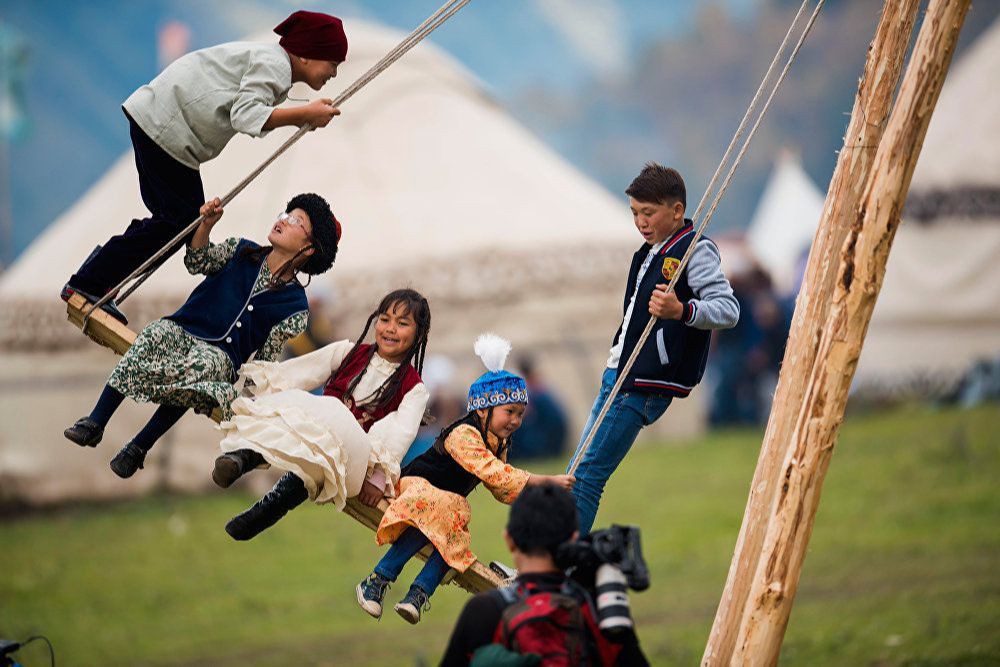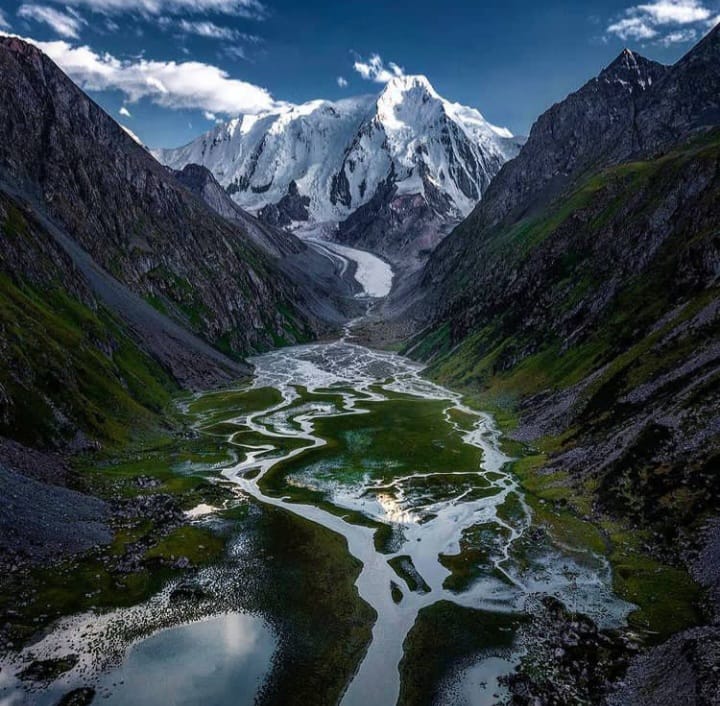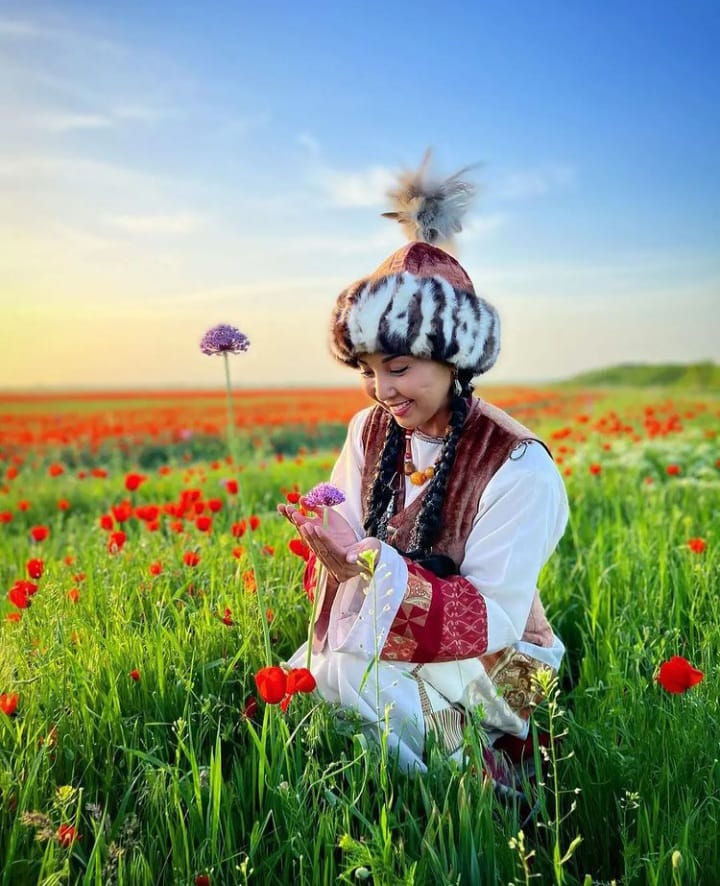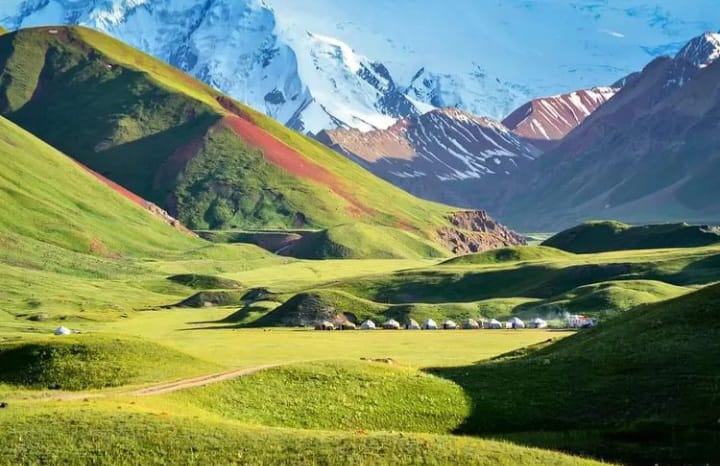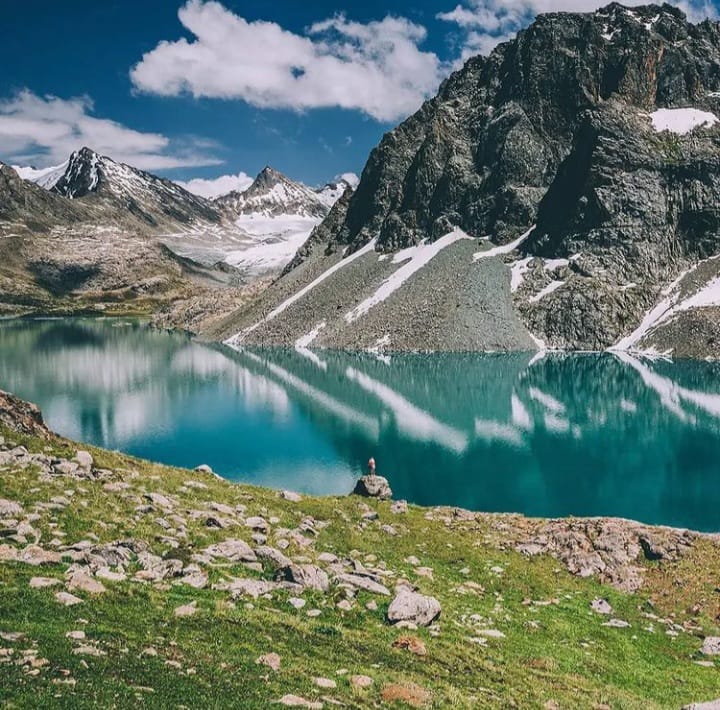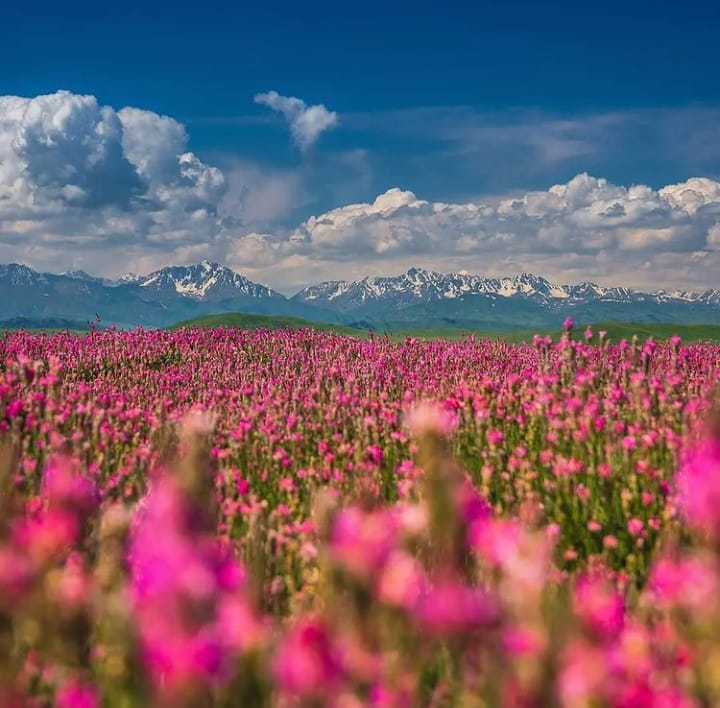INFORMATION ABOUT KYRGYZSTAN
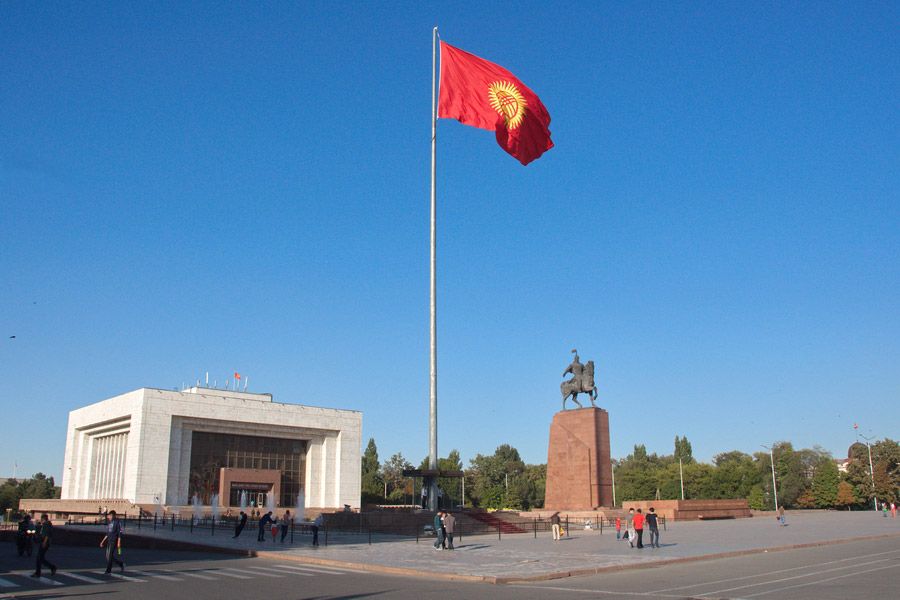
Kyrgyzstan is a fabulous, fascinating and alluring Central Asian country with its natural beauty. Its tourist potential is enormous! It is a dynamically developing republic with a rich history, unusual culture and many interesting traditions. Situated on the crossroads of Great Silk Road, Kyrgyzstan still keeps unique ancient monuments, which organically combine with modern buildings, can give you a lot of unforgettable experience. Excursion tours to Kyrgyzstan are very popular among the inquisitive tourists from near and far abroad.
Kyrgyzstan is a true "mountain paradise", nestled between the deserts of Uzbekistan, the steppes of Kazakhstan, the harsh highlands of Tajikistan and the sparsely populated, arid plains of Western China (Xinjiang). The two greatest mountain systems of the Earth - Tien Shan and Pamir, with the world's highest peaks - Pobeda Peak (7,439 m), Lenin Peak (7,134 m) and the most beautiful pyramidal peak Khan-Tengry (6,995 m) stretch over the entire territory of Kyrgyzstan. Mountain climbers, rock climbers, skiers, snowboarders, lovers of mountain hiking (trekking, hiking) and other extreme climbers go to the most beautiful mountain areas of Kyrgyzstan both in winter and summer.
Because of the majestic mountains and mild continental climate Kyrgyzstan is considered the land of the largest glaciers on the planet, the vast snowfields, rushing mountain rivers, turquoise high mountain lakes, charming motley grass and colorful alpine meadows and rich in a variety of flora and fauna of fertile valleys.
One of the main Kyrgyz "celebrities" is the Issyk-Kul Lake, which resorts and health resorts annually brings a huge number of fans of languid beach vacation.
The main cities of Kyrgyzstan are Bishkek and Osh. They are different, but in both reigns the atmosphere of good-naturedness, light and warmth.
In recent years the so-called Jailoo tourism - living in yurts of nomads deep in the Pamir and Tien Shan Mountains, in complete isolation from civilization - has been rapidly developing in the country.
Travelling through the natural and man-made sights of Kyrgyzstan is accompanied by the invariable hospitality of local people, unusual Kyrgyz cuisine and centuries-old traditions and customs of the ancient people.
Location. Located in the northeast of Central Asia, Kyrgyzstan can be confidently called Central Asian Switzerland, because these two countries have a lot in common. Like the European Switzerland, the territory of Kyrgyzstan is more than half mountainous, and even the lower parts of it do not fall below 401 meters above sea level. Neither country has access to the sea itself. Kyrgyzstan stretches from east to west along the Tien Shan and Pamir-Alai ranges. The highest peak is Pobeda Peak (7439 m). In the mountains, everything breathes with the untouched, pristine beauty, which you cannot see on the plains. The northern point of Kyrgyzstan is at the same latitude as Rome, and the southern point is on the island of Sicily.
Area. If you compare the size, the Central Asian mountain country is almost five times larger than Switzerland - its area is 199.9 thousand square kilometers. It could fit Portugal, Switzerland, Belgium and the Netherlands taken together.
Population. On these lands live more than five and a half million people. Since life in the mountainous regions is quite difficult, most of the population is concentrated in the valleys of Talas, Naryn, Chuysk and the Issyk-Kul Basin. The ethnic composition is diverse, but for the most part representatives of different peoples do not live together. For example, the Uzbeks, amounting to 14.3%, live in the south-west of the country; the Russians, represented by 7.8%, live mostly in the north; a small number of Germans live in Talas province and the region of Kant; Dungan (Muslim - Chinese) and Kazakhs live in the Chui Valley; the Uighurs live in Bishkek, Osh and Jalal-Abad. The Kyrgyz, of course, are the ethnic majority, living throughout the country and predominating in most rural areas.
Political structure. According to the Constitution, Kyrgyzstan is a parliamentary republic, which means that the president has less power than the prime minister and the parliament. The people elect the president once every six years, after which he can no longer run for office. The 120 members of parliament are approved for five-year terms on the basis of party lists, and the head of government is, in turn, determined by parliament itself.
The administrative division: According to the administrative division the country has 7 oblasts (Batken, Jalal-Abad, Issyk-Kul, Naryn, Osh, Talas and Chui), 40 districts, 22 cities and 429 rural municipalities. The main cities are Bishkek and Osh.
The capital is Bishkek with a population of 874,400 people, formerly the city was also called Pishpek and Frunze. Thanks to the orthogonal type of planning, it is wonderfully ventilated by air from the mountains. The constant inflow of fresh air distinguishes it from similar large cities of the region.
The state language is Kyrgyz, but the country has many speakers of Uzbek and Tajik. Russian, which has official status, is the main language of international communication.
The monetary unit is som. In Kyrgyzstan all payments are made in soms (1 som = 100 yyyn). Banks and exchange offices can be found in all big cities of the Republic.
Religions. The population reaches the spiritual richness by means of Islam (75%) and Orthodoxy (20%). Other religions account for only 5% of the citizens.
The standard time zone is UTC/GMT +5 hours. The time in the country is not divided into winter and summer and consistently equals +5 hours to Greenwich Mean Time.
Electricity. As in many other CIS countries, in Kyrgyzstan the voltage of electrical network is 220 V with a frequency of 50 Hz. Sockets are mostly standard, with double plugs. However, in some hotels you can also find triple plugs.
Relief and location of the country has caused that here you can plunge into different types of climates. This is almost marine, and sharply continental, subtropical and temperate. The peculiarity of Kyrgyzstan is also the way the seasons change, which is not surprising, because the nearest lands to it are rich in deserts.
The average air temperature here is not determined by the whole state at once, but by climatic zones. Thus, in winter the thermometer rarely falls below -8 degrees Celsius in the valleys, while in the highlands and 27 degrees of frost is not the limit. However, in summer the mountainous areas practically catch up with the lowlands. And in both those and others the average air temperature is about 26 degrees. Of course, in the high mountain areas of eternal snows the weather is very different and has all the signs of a subpolar climate. The air temperature on the coast of Issyk-Kul is less contrasting and moderate all year round (about +2°C in winter, +18-25°C in summer).
Visitors do not have to complain about the lack of sunny days - there are 247 days a year on average! You can find a cloudy sky in Kyrgyzstan only in winter and at the beginning of spring. In the rest of the time the region is bathed in sunshine, which is not as scorching as in the neighboring Uzbekistan. A characteristic feature is the dryness of the air over the entire territory of the country. Precipitation in the country is not uniform. For example, the northern slopes of Ala-Too get more than 1,000 mm per year, but the western Priissikkulje gets only 110 mm. The maximum amount of precipitation falls in early summer and in the autumn-winter period. And in the middle of winter the thickness of snow on the mountain slopes can reach up to 1 meter, and in the highlands it is snowing all year round.
Based on data on the country's climate, the preferred summer clothes are light shirts, shorts, pants and dresses. It is best if the fiber composition is mostly cotton. It allows the body to breathe and does not cause excessive sweating. Due to the low humidity in Kyrgyzstan, high temperatures are relatively easy to endure. You should wear wide-brimmed hats with necessary ventilation holes to protect your head.
You should also remember that white clothes absorb less sunlight. People who have eyes with an increased sensitivity to light should always have sunglasses.
As footwear in the city, open sandals are sufficient. On the part of the local culture there are no restrictions to the style and color of clothing. Except in religious places it is not recommended to appear in clothes that leave exposed the hips, calves, shoulders, and for women and the neck. Being invited into the house, one should take off his shoes before entering.
A completely different conversation if trips to the mountains, especially the highlands are planned. In general, you should keep in mind that it is much cooler in mountainous areas, especially at night, and that the weather is extremely changeable.
In today's Kyrgyzstan, you can find any dish of Uzbek, Russian, Turkish, or Iranian cuisine in almost every part of the country. The Kyrgyz people, of course, have their own culinary traditions, but because of their nomadic past, Kyrgyz cuisine is not particularly diverse.
For example, chicken dishes are absent in the national menu, because raising these birds required sedentary life. But there are all kinds of roasted and baked lamb in assortment. The nomadic way of life demanded it, because in the hot climate the meat can be preserved only by deep frying or curing it.
Different variants of sausages made of horse meat are considered the brightest representatives of Kyrgyz cuisine. The most revered variety is chuchuk, where the spicy taste is achieved by using fattier types of meat and smoking. Horse meat is used to make many other snacks and dishes, such as karta and karyn. Flavorful and hearty beshbarmak is also very common.
But, as it was mentioned above, the culture of the people has long been densely included in the culture of the country and dense with dishes from the cuisines of Uzbekistan, Tajikistan and Turkey, as well as Uyghur dishes. Great influence in this cuisine-mixing had the Great Silk Road, the merit of which was in the transfer of not only goods but also cultural peculiarities.
Honey is especially revered in Kyrgyzstan. Eaten with local tortillas, it can sometimes be the main breakfast dish. The locals also have a positive attitude to all kinds of fruits - in the summer and autumn period there is an abundance of them in all the bazaars of the country. Apples from Issyk-Kul are rightfully considered one of the best in the world! Pumpkin is one of the favourite vegetables of the Kyrgyz people.
Sour milk drinks: koumiss, tan, ayran make up a large part of the Kyrgyz national cuisine. One can buy it in any bazaar, in any store and even along mountain roads.
Kirghiz people usually eat at dasturkhan (dastarkhan), a narrow tablecloth spread on the floor. If you are lucky to be invited to the table, and it is likely to be because of Kyrgyz hospitality, you should remember a few important rules: take food only with right hand, when sitting down the legs should not be directed towards dastarkhan, it is better to put them under yourself or pull them aside. Sneezing at the table is also negative.
The cost of food in Kyrgyzstan.
Menus in cafes and restaurants in Kyrgyzstan rarely contain high price tags. Meals in Kyrgyzstan are quite cheap. For example, lunch usually does not exceed 10 U.S. dollars, and a heavy dinner - 20. However, in the capital there are also elite institutions, where for a cup of coffee you have to pay more than 10 dollars. As a rule, restaurants and cafes of Kyrgyzstan offer dishes of national as well as Uzbek, Uighur, European and other cuisines of the world.
Legally in the territory of Kyrgyzstan it is allowed to pay only in soms - monetary units of the Kyrgyz Republic, which were put into circulation on May 10, 1993. Currently, the banknote range is represented by the following denominations: 1, 10, 50 tyyyn and 1, 5, 10, 20, 50, 100, 200, 500, 1000 and 5000 soms.
Sometimes there may be offers to pay in foreign currency from the hotel staff and other private organizations. This can be done only if the company has the appropriate official permission. In other cases, problems may arise with law enforcement agencies.
However, in order to completely exclude such misunderstandings from your touristic program it is recommended to exchange cash for the local currency beforehand. It can be done in banks working usually from 9.00 to 17.00 except Saturdays and Sundays or in official exchange offices many of which operate 24 hours a day.
It is worth noting that the rate in different exchange offices may vary, and the rate in the capital is always higher than in the province. When exchanging money it is advisable to keep the documents issued by the bank or bureau de change officer. Do not be surprised that some exchange offices may refuse to accept badly worn bills or old U.S. dollar bills.
Never change money in the bazaar with strangers - there is a risk of becoming a victim of fraudsters, or be detained by law enforcement officers for illegal currency transactions. Foreign plastic cards can be used only in some shopping centers, banks and hotels in Bishkek.
Admiring the splendor of ancient monuments of Kyrgyzstan, its Issyk-Kul lake and snow-covered mountain peaks you may forget that you will want to keep the memories of this wonderful place for a lifetime. Therefore, the question of choosing souvenirs should be given if not the first, at least the second place.
Apart from all sorts of carpets and carved wood items common in almost all Central Asian countries, quite entertaining things are made of felt. It is associated with the nomadic past of the people. Souvenirs in the form of national Kyrgyz yurts in a large variety of pre
Flag of Kyrgyzstan. The national flag of the Republic of Kyrgyzstan is a red cloth, in the center of which there is a round sun disk with forty evenly diverging golden rays. Inside the sun disk in red is a picture of a Kyrgyz yurt turd.
The red monochrome of the flag symbolizes the valor and bravery of the Kyrgyz people. The golden sun bathing in its rays represents peace and wealth, and the turkey is a symbol of the home, in a broader sense - the world as a universe.
Forty rays united in a circle symbolize the union of forty ancient tribes into a single Kyrgyzstan. The tunduk symbolizes the unity of the peoples living in the country. The red color of the flag was the color of the flag of the magnanimous Manas (Manas - the hero of the Kyrgyz epic of the same name - the hero who united the Kyrgyz).
Emblem of Kyrgyzstan. The emblem of Kyrgyzstan depicts a gyrfalcon of Manas with outstretched wings, which symbolizes the country's freedom. Also depicted on the symbol of the republic is the jewel of Kyrgyzstan, Lake Issyk-Kul, surrounded by the high rocky ranges of the Ala-Too Mountains. White mountain tops illuminated by the sun are a symbol of Kyrgyz pride in the beauty of their native land, their outlines resemble a white hubcap - the traditional Kyrgyz male headdress. Coat of Arms of the Republic of Kyrgyzstan was approved on January 14, 1994 by resolution of the Jogorku Kenesh (Parliament of Kyrgyzstan).
3-D map of Kyrgyzstan Virtual Tour (tourism.gov.kg)
